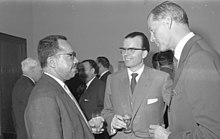Arab Nationalists Movement

The Arab Nationalists Movement ( Arabic حركة القوميين العرب, DMG Harakat al-qaumīyīn al-'arab ), inaccurate as Arab Nationalist Movement ( English Arab Nationalist Movement ) translated and often only briefly as Haraka (or Harakat called) was a pan-Arab revolutionary organization in several Eastern Arabian countries. It was strongly influenced by Nasserism and in 1964 was absorbed into the Arab Socialist Union and other Nasserist parties. The Popular Front for the Liberation of Palestine emerged from its Palestinian section ; from its Yemeni section the Dhofar Liberation Front and the Popular Front for the Liberation of the Occupied Arabian Gulf .
Arab Nationalist Youth
The Haraka was created in 1952 among Lebanese, Syrian and Palestinian students at the American University of Beirut and was initially called the Arab Nationalist Youth . Its most important founding fathers included the Palestinian doctors George Habasch and Wadi Haddad as well as the Kuwaiti Ahmad al-Khatib, and their mentor was the Syrian professor Constantin Zureik . Angry about the expulsion of the Palestinians and the failure of the regular armies of the reactionary Arab regimes in the Palestine War of 1949, the students published an illegal weekly newspaper from 1952, the "Bulletin of Vengeance". Under the motto “Unity, Freedom, Vengeance”, they called for the mobilization of the entire Arab people for the liberation of Palestine and the overthrow of the reactionary regimes. Under the influence of the Egyptian revolution of 1952 and Nasser's gain in prestige during the Suez crisis , the movement chose the Egyptian president as its idol. Independent offshoots emerged in Syria, Iraq and Jordan, and in 1956 the first inter-Arab national conference was held. In 1958 the movement was finally called the Movement of Arab Nationalists .
Successor organizations

After the collapse of the Egyptian-Syrian union (1958–1961), the Nasserists in the Harakat, as zealous unionists, tried to reunite with Egypt , but rivaled the Ba'ath party and joined forces in both Syria and in July 1964 Iraq merged with other socialist groups to form the Arab Socialist Union (ASU).
The hopes of the Palestinians for “unity, liberation and revenge” with Egyptian help were not fulfilled, however, and so after Nasser's defeat in the Six Day War in 1967 the Palestinian Haraka section led by Habasch united with two more radical Palestinian groups to form the Popular Front for the Liberation of Palestine (PFLP ).
In South Yemen , the Haraka merged with other Nassist and nationalist groups in 1963 to form the National Liberation Front (NLF), in which, however, from 1969 left, Marxist forces prevailed, which combined the liberation front with Baathists and communists to form the Yemeni Socialist Party .
The Dhofar Liberation Front , established in Oman in 1962, was an offshoot of the Yemeni Haraka Section and later became the Popular Front for the Liberation of the Occupied Arabian Gulf and the Popular Front for the Liberation of Oman and the Arabian Gulf (PFLOAG).
There were also Haraka offshoots in Kuwait and Saudi Arabia, in Kuwait al-Khatib and some of his supporters briefly sat in parliament.
See also
literature
-
Lothar Rathmann : History of the Arabs - from the beginnings to the present
- Volume 5 (The collapse of the imperialist colonial system and the formation of sovereign Arab nation states), page 211. Akademie-Verlag, Berlin 1981
- Volume 6 (The Struggle for Development in the Arab World, Part 1), pages 202, 300, 322 and 325. Akademie-Verlag, Berlin 1983
- Volume 7 (The Struggle for Development in the Arab World, Part 2), pages 476 and 479. Akademie-Verlag, Berlin 1983
- Martin Robbe : Crossroads in the Middle East , page 162f. Military publishing house of the GDR, Berlin 1987
- Robin Leonard Bidwell : Dictionary of Modern Arab History , 43. Routledge, New York 2010
- Robert D. Burrowes: Historical Dictionary of Yemen , 33-33. Lanham 2010
- Dilip Hiro: A Comprehensive Dictionary of the Middle East , page xx. Northampton 2013
- David Seddon: Political and Economic Dictionary of the Middle East , xx. Routledge, New York 2013
Individual evidence
- ↑ Dr. Werner Rosenberg : Die Welt - data, facts and information of the year 1965 , page 285 (Iraq). Dietz Verlag Berlin 1966